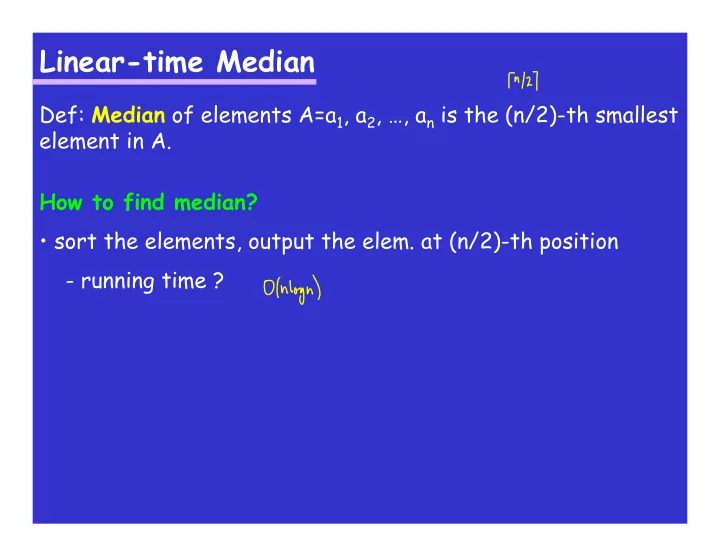

Linear-time Median Def: Median of elements A=a 1 , a 2 , …, a n is the (n/2)-th smallest element in A. How to find median? • sort the elements, output the elem. at (n/2)-th position - running time ?
Linear-time Median Def: Median of elements A=a 1 , a 2 , …, a n is the (n/2)-th smallest element in A. How to find median? • sort the elements, output the elem. at (n/2)-th position - running time: (n log n) • we will see a faster algorithm - will solve a more general problem: SELECT ( A, k ): returns the k-th smallest element in A
Linear-time Median Idea: Suppose A = 22,5,10,11,23,15,9,8,2,0,4,20,25,1,29,24,3,12,28,14,27,19,17,21,18,6,7,13,16,26
Linear-time Median SELECT (A, k) 1. split A into n/5 groups of five elements 2. let b i be the median of the i-th group 3. let B = [b 1 , b 2 , …, b n/5 ] 4. medianB = SELECT (B, B.length/2) 5. rearrange A so that all elements smaller than medianB come before medianB, all elements larger than medianB come after medianB, and elements equal to medianB are next to medianB 6. j = position of medianB in rearranged A (if more medianB’s, then take the closest position to n/2) 7. if (k < j) return SELECT ( A[1…j-1], k ) 8. if (k = j) return medianB 9. if (k > j) return SELECT ( A[j+1…n], k-j )
Linear-time Median Running the algorithm:
Linear-time Median Running the algorithm: Rearrange columns so that medianB in the “middle.” Recurrence:
Linear-time Median Recurrence: T(n) < T(n/5) + T(3n/4) + cn if n > 5 T(n) < c if n < 6 Claim: There exists a constant d such that T(n) < dn.
Randomized Linear-time Median Idea: Instead of finding medianB, take a random element from A. SELECT-RAND (A, k) 1. x = a i where i = a random number from {1,…,n} 2. rearrange A so that all elements smaller than x come before x, all elements larger than x come after x, and elements equal to x are next to x 3. j = position of x in rearranged A (if more x’s, then take the closest position to n/2) 4. if (k < j) return SELECT-RAND ( A[1…j-1], k ) 5. if (k = j) return medianB 6. if (k > j) return SELECT-RAND ( A[j+1…n], k-j)
Randomized Linear-time Median Worst case running time: O(n 2 ). SELECT-RAND (A, k) 1. x = a i where i = a random number from {1,…,n} 2. rearrange A so that all elements smaller than x come before x, all elements larger than x come after x, and elements equal to x are next to x 3. j = position of x in rearranged A (if more x’s, then take the closest position to n/2) 4. if (k < j) return SELECT-RAND ( A[1…j-1], k ) 5. if (k = j) return medianB 6. if (k > j) return SELECT-RAND ( A[j+1…n], k-j)
Randomized Linear-time Median Worst case running time: O(n 2 ). Claim: Expected running time is O(n).
Master Theorem Let a ≥ 1 and b>1 be constants, f(n) be a function and for positive integers we have a recurrence for T of the form T(n) = a T(n/b) + f(n), where n/b is rounded either way. Then, • If f(n) = O(n log a/log b - e ) for some constant e > 0, then T(n) = (n log a/log b ). • If f(n) = (n log a/log b ), then T(n) = (n log a/log b log n). • If f(n) = (n log a/log b + e ) for some constant e > 0, and if af(n/b) ≤ cf(n) for some constant c < 1 (and all sufficiently large n), then T(n) = (f(n)).
Recommend
More recommend